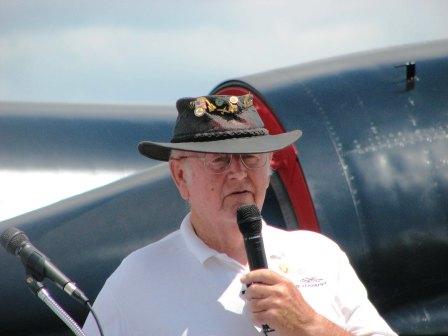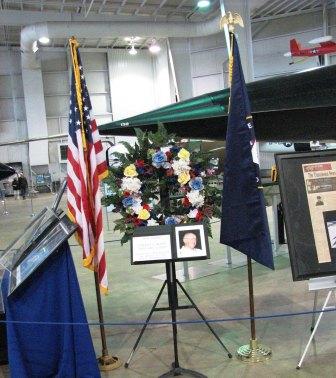


 |
 |
 |


My initial exposure to cold war activities started while in the Army (1955 to 1958) as a H-21 helicopter mechanic at Fort Belvoir, Virginia, the H-21 helicopters supported the evacuation of key offices at the Pentagon and other government facilities. When my security clearance was raised from secret to top-secret I was curious of the reason but soon found that I was the selected enlisted Army NCO to staff the retreat where President Eisenhower was evacuated.
At the end of my three-year enlistment I started college with the goal of Bachelor of Science in Aeronautical Engineering this goal was achieved at Cal Poly-San Luis Obispo, University completing my degree in December of 1963. I started employment with Lockheed California Co., Burbank California in the Lockheed Skunk Works flight test organization in February 1964. I feel timing has a great deal to do with opportunities and this is a case that underscores that to me every time I think about it. My experience at this point in time included the hands-on construction of several crop duster type aircraft; my aircraft and power plant (A&P) mechanics license with the FAA was a key consideration in my selection.
The Mach 3 in environment that the test aircraft was going to be developed for also used some special activities training that I participated in an assisting in bringing the Wind Tunnel at Cal Poly online and routinely tested in the Mach 2 to 3 speed range this experience gave me an insight into a number of the problems that we encountered.
My assignment was to prepare the test requirements for ground testing and verification of these systems aboard the YF-12 interceptor; there were a very few similarities between the CIA version of the blackbird and the YF-12 interceptor from a systems perspective. The preparation of the ground test plans for hydraulics, fuel system, electrical system and the air-conditioning all systems were widely different than any of the A-12 comparable systems. When the YF-12 was completed in production and shipped to the Nevada test site several of us in the test engineering group monitored the reassembly and conducted the ground test plans that we had generated and at the conclusion of the ground test activities I was surprised to find myself selected by my department head to be the Senior Test Engineer on Ship 1001 I remained as the Senior test engineer on YF-12 1001 for its first 13 flights. At this point YF-12 1002 arrived from production and I was assigned as the Senior Test Engineer on that aircraft where I stayed in that capacity for 158 of its first flights. During this period of testing we had completed the activities at the Nevada test site and relocated our operation to Edwards Air Force Base where we did the missile firing at the Pt Magu Naval Test Ranges in California, and had deployed to Eglin Air Force Base, Florida for a live firing against the QB-47 test droned aircraft.
When the YF- 12 aircraft program was concluded I was reassigned to the Nevada test site to support the flight test activity on the A- 12 [CIA photo reconnaissance aircraft] I returned to the A- 12 program a few weeks before the first A- 12 was deployed to Kadena Air Force Base, Okinawa Japan my assignment was to monitor the progress towards the first flight departing the Nevada test site for Okinawa Japan, I was the test engineer that read the checklist to Mel Vojvodich prior to his departure.
In January 1968 I transferred from the Lockheed skunk Works to the Cheyenne AH-56 helicopter where I conducted the rotor system development testing at the ground whirl test facility at Lockheed's Rye Canyon; then went on to the gun and missile firing weapons system development at the Yuma, Arizona proving grounds.
In August 1972 I was reassigned as design manager for aircraft modifications that Lockheed Air Service Ontario, California in about two years I was then transferred to a international activity where I was involved with the development of a Greek Depot level overhaul facility that then led to a assignment as a international facility development manager that took me to several remote places such as Nairobi, Kenya, Algiers, Algeria, and Lagos Nigeria.
In April 1978 I returned to the skunk Works where I was the flight test manager for the development of the SR-71 and the U-2 aircraft.
A year later, in April 1981 I was assigned in the Project office for the development of the stealth F- 117 aircraft as a staff manager in that program my assignments were varied and in February of 1986 I was in a preliminary design group working on new concept stealth projects and the concept stealth projects working on multiple new concepts most of which were remotely piloted vehicles. The drive from Montclair to Burbank became such a risky part of the day several near misses with freeway collisions. I decided to return to Lockheed Air Service at Ontario. In October 1989, I felt the LAS division of Lockheed Corporation no longer met the standards that I had become accustomed to working in the Skunkworks.
The first contract that I signed up was with the San Diego Aerospace Museum for pylon mounting and providing the engineering package for both preparations for transport, as well as mounting the aircraft on three support pylons. This San Diego contract provided the funds to complete my work on the design to mount the A-12 aircraft for the museum. Concurrent with the San Diego contract, I had an agreement with "World Wide Aircraft Recovery" that they could use the design to process three other blackbird aircraft and that future aircraft would require them to pay for the engineering each time they used it.
This note is being generated in May 2008. The relationship with "Worldwide Aircraft Recovery" has been a very good relationship and 18 blackbirds have been relocated to museums at this time.
During the midnight team ninetieths accepted employment with DuPont Aerospace, and that give it a headed by Tony DuPont at Gillespie Field San Diego, California. Tony DuPont's concept of direct lift from the thrust of jet engine required several things to come together prior to his concept being practical. The high by pass fan engines that are on the market in the late 90s included a high bypass fan the engine by Pratt & Whitney engine group the V-2500. This engine was of a nature that they combining the core high temperature and air and the bypass fan air when properly blended would produce 30,000 pounds of thrust at a mixed temperature of approximately 700F. This combination of engine thrust and output temperature was compatible with a high-temperature composite materials and epoxies that a nozzle could be fabricated. That would rotate the horizontal thrust vector from the engine to a vertical thrust post. Tony and I worked with a team of new graduates from the San Diego University to build a composite thrust box and produce a the test unit to statically cast in on the thrust stands at the Pratt & Whitney facilities in Florida. The demonstration of this prototype thrust box was used to convince the US Air Force that a $15 million follow-on development contract should be released and was under contract within 12 months.
Activities undertaken after the DuPont experience included pylon mounting of the trainer A- 12 blackbird aircraft for the Los Angeles Museum.
A third pylon mounted A-12 aircraft was completed in December of 2007 at the CIA headquarters at Langley Virginia.
Interleaved with the above as a retiree I have undertaken the design and construction of a 1931 Curtis Jr., this aircraft is a bit unique in that it is a pusher high wing monoplane that has 39 1/2' wingspan and a takeoff and landing speed characteristics that are unique in that 28 miles an hour is impressive to most general aviation pilots. At the time of this writing the aircraft is partially completed in that the engine mount is in place engine installation.
TORREY LARSEN
 1 January 2010 - The Roadrunners and the aviation world lost one of our aviation icons on the first day of the new decade. Torrey passed away Friday night (1 Jan). Apparently Torrey had fallen off a ladder several days ago hitting his head very hard on the pavement. The funeral was Friday the 8th of January at 11:00 AM at the Ontario Elks Lodge, 1150 West 4th St., Ontario, 91762. Approximately 70 of his friends and family attended his funeral. Friends from around the world sent their condolences to the family.
1 January 2010 - The Roadrunners and the aviation world lost one of our aviation icons on the first day of the new decade. Torrey passed away Friday night (1 Jan). Apparently Torrey had fallen off a ladder several days ago hitting his head very hard on the pavement. The funeral was Friday the 8th of January at 11:00 AM at the Ontario Elks Lodge, 1150 West 4th St., Ontario, 91762. Approximately 70 of his friends and family attended his funeral. Friends from around the world sent their condolences to the family.
Among them were the director and staff at the Battleship Memorial Park Museum in Mobile, Alabama, the retirement home of A-12 Article 132. Mike Thompson, curator at the museum said, "Sorry to hear that Torrey is gone. He was a fine person. It was quiet an honor to have known him.He helped with moving art 132 to Mobile and that was the first time we met. Such forsight,knowledge,kindness,passion to his work and a lot of fun to be around. I just wish I could have talked to him one more time. I am going to set up a tribute to Torrey in front of art.132 today so that the visitors will know that Torry is on his final flight home. My thoughts and prayers will be with his family."
1-9-2010 - Director Bill Tunnell, Mike Thompson, Owen Miller and the rest of the Battleship Memorial Park Museum crew did exactly as Mike said they would, displaying an outstanding remembrance and tribute to Torrey.


 |
 |
 |